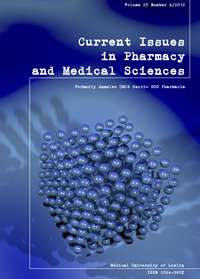Influence of adenosine receptor ligands on ketamine-induced anesthesia in mice
DOI:
https://doi.org/10.12923/j.2084-980X/25.4/a.10Keywords:
ketamine, adenosine, the loss of the righting reflex time, miceAbstract
The influence of adenosine receptor ligands on anesthetic activity of ketamine was studied in mice. Ketamine-induced anesthesia (100 mg/kg) was significantly increased by the higher doses of CPA (selective A1 adenosine receptor agonist) and NECA (A1/A2 adenosine receptor agonist). CGS 21680 (selective A2A receptor agonist) markedly but not significantly prolonged this ketamine effect. Administration of both selective adenosine receptors antagonists DPCPX (A1) and DMPX (A2A) resulted in significant decrease in the duration of ketamine-induced anesthesia. Caffeine (A1/A2 adenosine receptor antagonist) dose-dependently but not significantly diminished the anesthetic effect of ketamine. The results suggest that adenosinergic system is involved in ketamine anesthetic activity and seem to appear that the effects are connected with both type (A1 and A2A) of adenosine receptors.
References
1. Allgaier C., Hertting G., Kugelgen O.V.: The adenosine receptor-mediated inhibition of noradrenaline release possibly involves a N-protein and is increased by 2-autoreceptor blockade. Brit J Pharmacol, 90, 403-412, 1987.
2. Brown R.E., Basheer R., McKenna J.T. et al.: Strecker RE, McCarley RW: Control of sleep and wakefulness. Physiol Rev, 92, 1087-1187, 2012.
3. Brundege J.M., Dunwiddie T.V.: Role of adenosine as a modulator of synaptic activity in the central nervous system. Adv Pharmacol, 39, 353-391, 1997.
4. Chen G., van den Pol A.N.: Adenosine modulation of calcium currents and presynaptic inhibition of GABA release in suprachiasmatic and arcuate nucleus neurons. J Neurophysiol, 77, 3035-3047, 1997.
5. Domino E.F., Chodoff P., Corssen G.: Pharmacologic effects of CI-581, a new dissociative anesthetic, in man. Clin Pharmacol Ther, 6, 279-291, 1965.
6. Feuerstein T.J., Bär K.I., Lücking C.H.: Activation of A1 adenosine receptors decreases the release of serotonin in the rabbit hippocampus, but not in the caudate nucleus. Naunyn-Schmied Arch Pharmacol, 338, 664-670, 1988.
7. Fredholm B.B.: Adenosine receptors in the central nervous system. News Physiol Sci 10, 122-128, 1995.
8. Gass N., Porkka-Heiskanen T., Kalinchuk A.V.: The role of the basal forebrain adenosine receptors in sleep homeostasis. Neuroreport, 20, 1013-1018, 2009
9. Holins C., Stone T.W.: Adenosine inhibition of γ-aminobutyric acid release from slices of rat cerebral cortex. Br J Pharmacol, 69, 107-112, 1980.
10. Ikemoto Y.: Ketamine depression of excitatory and inhibitory cholinergic responses in Aplysia neurons. Eur J Pharmacol, 132, 97-100, 1986.
11. Irifune M., Shimitzu T., Nomoto M., Fukuda T.: Ketamine-induced anesthesia involves the N-methyl-D-aspartate receptor channel complex in mice. Brain Res, 596, 1-9, 1992.
12. Irifune M., Sato T., Kamata Y.et al: Evidence for GABAA receptor agonistic properties of ketamine: convulsive and anesthetic behavioral models in mice. Anesth Analg, 91, 230-236, 2000.
13. Kubota T., Anzawa N., Hirota K. et al.: Effects of ketamine and pentobarbital on noradrenaline release from the medial prefrontal cortex in rats. Can J Anaesth, 46, 388-392, 1999.
14. Kubota T., Hirota K., Anzawa N. et al.: Physostigmine antagonizes ketamine-induced noradrenaline release from medial prefrontal cortex in rats. Brain Res, 840, 175-178, 1999.
15. Mimura M., Namiki A., Kishi R. et al.: Antagonistic effect of physostigmine on ketamine-induced anesthesia. Psychopharmacology, 102, 399-403, 1990.
16. Morairty S., Rainnie D., McCarley R., Greene R.: Disinhibition of ventrolateral preoptic area sleep-active neurons by adenosine: a new mechanism for sleep promotion. Neurosci., 123, 451-457, 2004.
17. Porkka-Heiskanen T., Kalinchuk A.V.: Adenosine, energy metabolism and sleep homeostasis. Sleep Med Rev, 15, 123-135, 2011
18. Radulovacki M., Virus R.M., Djuricic-Nedelson M., Green R.D.: Adenosine analog and sleep in rats. J Pharmacol Exp Ther, 228, 268-274, 1984.
19. Sawynok J., Jhamandas K.H.: Inhibition of acetylcholine release from cholinergic nerves by adenosine, adenine nucleotides and morphine: antagonism by theophylline. J Pharmacol Exp Ther, 197, 379-390, 1976.
20. Song W.J., Tkatch T., Surmeier D.J.: Adenosine receptor expression and modulation of Ca2+ channels in ratstriatal cholinergic interneurons. J Neurophysiol, 83, 322-332, 2000.
21. Sussman D.R.: A comparative evaluation of ketamine anesthesia in children and adults. Anesthesiology, 40 , 459-464, 1974.
22. Thakkar M.M., Winston S., McCarley R.W.: A1 receptor and adenosinergic homeostatic regulation of sleep-wakefulness: effects of antisense to the A1 receptor in the cholinergic basal forebrain. J Neurosci, 23, 4278-4287, 2003.
23. Tung A., Herrera S., Szafran M.J. et al.: Effect of sleep deprivation on righting reflex in the rat is partially reversed by administration of adenosine A1 and A2 receptor antagonists. Anesthesiology, 102, 1158-1164, 2005.
24. Van Dort C.J., Baghdoyan H.A., Lydic R.: Adenosine A(1) and (A2) receptors in mouse prefrontal cortex modulate acetylcholine release and behavioral arousal. J.Neurosci, 29, 871-881, 2009.
25. Yamamura T., Harada K., Okamura A., Kemmotsu O.: Is the side of action of ketamine anesthesia the N-methyl-D-aspartate receptor? Anesthesiology, 72, 704-710, 1990.
Downloads
Published
Issue
Section
License
Copyright (c) 2012 Authors

This work is licensed under a Creative Commons Attribution-NonCommercial-NoDerivatives 3.0 Unported License.


